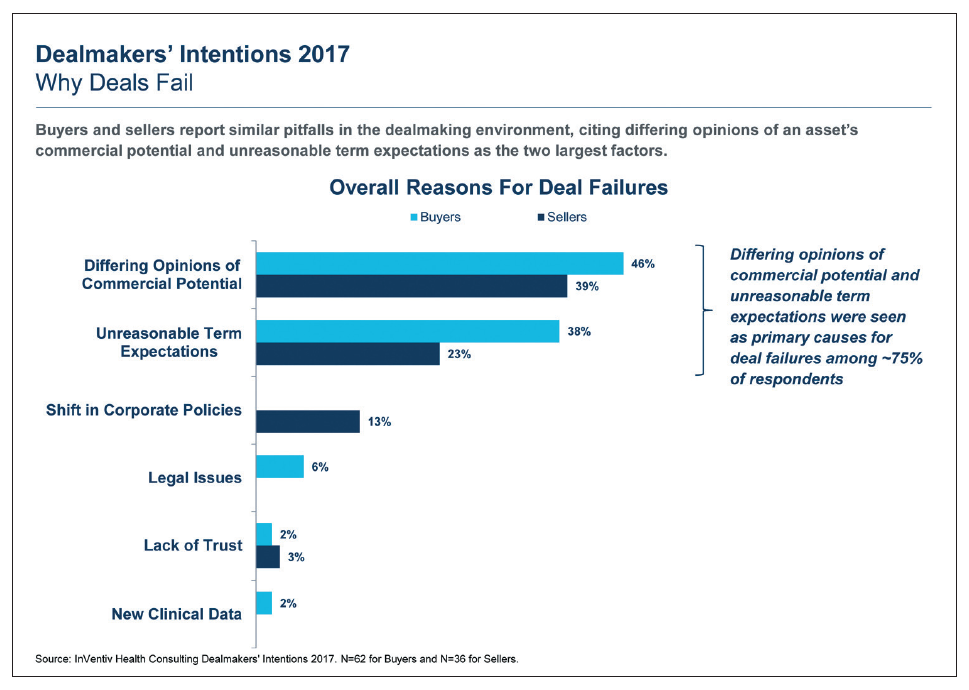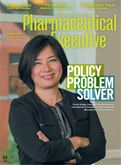Dealmaking in 2017: Striking a Balance
Experts assess the current pharma dealmaking landscape-one where, despite market headwinds, is still heavily influenced by factors under the buyer and seller’s control.
inVentiv Health Consulting’s Neel Patel tells Pharm Exec that biopharma dealmaking in 2017 is robust and generally immune to external pressures in the short term-but the art of the deal is still being compromised by factors under the buyer and seller’s control
While life sciences dealmaking in 2016 fell short of matching 2015-when deal value stood at approximately $425 billion, more than double the deals seen in 2014-it was “still high in historical terms,” according to inVentiv Health Consulting’s latest Dealmakers’ Intentions Study, released at a Super Session at this year’s BIO International Convention in San Francisco, CA. The drop in value to $275 billion-primarily attributed to 2016 M&A activity, which fell to $114 billion from $278 billion the year before-shows deal activity “leveling out” and moving closer to historical norms. The study forecasts that 2017, however, will still rank among the top three in value since inVentiv issued its first dealmakers report in 2008.
The study-which surveyed 107 members of the biopharma community “who participate on both sides of deals and who have predominantly executive-level influence on decision-making”-points to the continued growth of financing to small-cap and private biopharma companies in 2015, which remained steady through 2016 at $20 billion. “Financing in this range-far above the $6 billion to $8 billion range that we saw from 2009 to 2012-appears to be the new normal,” the study reports. Driving this trend is the emergence of new
Neel Patel

buyers and more financing options, from venture capital and other vehicles that are available to emerging companies and innovators. “Decision-makers are continuing to think creatively about new partnership opportunities. True innovators can expect to benefit from the emergence of new buyers and more financing options from the capital markets, permitting them to hold on to assets through commercialization in some disease areas,” said the study’s co-author Neel Patel, managing director, inVentiv Health Consulting, part of INC Research/inVentiv Health. However, he added, “Success with this strategy requires a clear understanding of the long-term potential of their assets in a rapidly evolving buyer’s market and payer landscape.”
Supply and demand
Both the seller’s and buyer’s markets continue to be shaped by imbalances in supply and demand and the continued struggle for both sides to reach a common understanding of an asset’s value. Where there is a seller’s market for all areas of hepatic disease (including non-alcoholic steatohepatitis [NASH]), women’s health and CNS-neurology assets, a buyer’s market exists in cardiovascular, oncology, CNS-psychiatry, inflammation, and autoimmune disease. Oncology, according to the report, is one area where “buyer enthusiasm appears to have tapered relative to supply;” however, “the volume of development activity has kept this therapeutic area in a buyer’s market mode overall for the second year in a row.”
Speaking to Pharm Exec, Patel noted that oncology had been for several years a seller’s market, largely driven by the high demand among buyers, but this has now been “somewhat eclipsed by the sheer volume of assets available.” He adds: “It is going to be important for buyers to understand where there is value among all the assets available, and sellers need to understand that oncology can be a challenging place for dealmaking, despite the high interest.”
Noting also that in 2016 there were many deals related to CNS and NASH, Patel says: “Buyers need to be careful in those areas where asset value has risen tremendously and maybe look at areas where there is relatively less demand, if it sits within their strategic remit, for areas where they may be able to get assets at better value for the money they’re spending.”
Sellers have less flexibility, says Patel, but being aware of where they sit and being able to drive negotiations and drive more value are important in terms of their therapeutic area and the relative demand. He adds: “Every year we track the total opportunities considered by buyers, and how each of these moves from entering a confidential discussion to issuing a term sheet to a completed transaction. The probability of progressing to a deal is between 4% and 8%. Compare that to the probability of a Phase I product across all therapeutic areas getting to approval, which is about 10%. It is about being aware how difficult the process is from start to finish. Having a sense of the magnitude of the effort required to successfully get a deal in place is important for sellers.”
Deal or no deal: Influencing factors
Given the heated public debates and increasing political pressure in areas such as drug pricing, it is perhaps surprising that inVentiv’s study shows that deal failures are driven mainly by internal factors, i.e., those under the dealmakers’ control. Buyers and sellers report similar pitfalls in the dealmaking environment, the study reports. “More than 75% of respondents zeroed in on two main reasons for deal failure: differing opinions about an asset’s commercial potential and unreasonable term expectations.” (See chart below).
For Cliff Kalb, Pharm Exec Editorial Advisory Board (EAB) member and president, C. Kalb and Associates, it seems “ironic that, just as pharma has struggled with defining value for their products with stakeholders, settling on a common understanding of an asset’s value is a major obstacle to dealmaking.”
However, he adds, “This has never been easy, and it appears that will remain the case. The devil is always in the details of these transactions.”

Indeed, Patel says that internal factors-which also include cash balance and access to capital-have “consistently been the drivers for deals since we began doing the surveys.” The major factor affecting deal failure is differing opinions of asset value. This factor can be mitigated, within reason, by deal structure, he adds, but it is still one of the main reasons why deals fail. Pricing pressures, the effect of the political landscape and changes to affordable care, for example, continue to score relatively low in the study as far as affecting dealmaking is concerned. Regarding pricing, Patel notes that buyers, in particular, “have been incorporating these concerns in their modeling and their commercial diligence for several years, maybe for as long as a decade. Sellers have also realized that this is the new world order, and have had a couple of years to incorporate it into their thinking.”
As Patel explains, the inVentiv study is focused on the dealmaking outlook in the short term. While, to his surprise, one external factor-the number of FDA product approvals-was regarded as affecting dealmaking in the short term, such external drivers generally present more long-term concerns.
Dealmaking horizon
Some “outside forces,” however, may yet prove influential in the shorter term. The inVentiv study notes that “the Trump administration’s stated intention to incentivize US companies to repatriate their overseas cash could spark a new wave of life science dealmaking.” This could be one of the “catalysts for upside,” adds Patel, that may fuel “major M&A consolidation among bigger companies that are rumored to be on a take-out list.”
Conversely, Peter Young, of Young and Partners and Pharm Exec EAB member, notes that “uncertainty about what will happen with drug pricing and Trump’s tax reforms, particularly around the repatriation of foreign earnings, has contributed to some of the slowdown in pharma and biotech M&A deals.” Young points out that the blocking of tax inversion transactions by the US Treasury Department has “clearly halted almost all of the tax inversion-motivated deals, many of which were quite large.” The “Trump bounce” and its influence on the dealmaking landscape seems open to interpretation. For Ipsos Healthcare president and Pharm Exec EAB member Steve Girling, the “trickle-down effect has been positive.” He explains: “The balance of buyers and sellers is undoubtedly better because of the strength of the economy and its overall momentum, which underpins stock price and gives both parties in any transaction more confidence.”
The Dealmakers’ Intentions Study concludes that, “in many respects, this is still a seller’s market.” Girling adds that “the rationale for a deal may continue to hinge on seller CEO confidence in their company’s clinical/commercial capabilities and ability to scale.” The survey states that the widening discount rate gap between in-licensers and out-licensers in 2017 (4% spread vs. 2% in 2016) “potentially indicates an acceleration in dealmaking activity over time,” adding that “a similar trend occurred in 2013 and catalyzed the unprecedented activity observed in 2015.”
Given this scenario, comparable growth can be anticipated in 2019-but even then, dealmaking is unlikely to reach the giddy heights of 2015.
Julian Upton is Pharm Exec’s Online and European Editor. He can be reached at julian.upton@ubm.com

The Misinformation Maze: Navigating Public Health in the Digital Age
March 11th 2025Jennifer Butler, chief commercial officer of Pleio, discusses misinformation's threat to public health, where patients are turning for trustworthy health information, the industry's pivot to peer-to-patient strategies to educate patients, and more.
Navigating Distrust: Pharma in the Age of Social Media
February 18th 2025Ian Baer, Founder and CEO of Sooth, discusses how the growing distrust in social media will impact industry marketing strategies and the relationships between pharmaceutical companies and the patients they aim to serve. He also explains dark social, how to combat misinformation, closing the trust gap, and more.